Welcome to our comprehensive Paint Guide! Your go-to resource for interior painting‚ offering step-by-step guides‚ expert tips‚ and inspiration to achieve a professional-quality finish. Transform your space with confidence!
1.1 Overview of Painting Basics
Painting basics involve understanding essential steps and materials for a successful project. Start by assessing the room‚ selecting the right tools‚ and choosing appropriate paints. Preparation is key‚ including cleaning and repairing walls. Primer may be needed for better coverage. Always test paint samples and plan your approach. Proper techniques ensure a smooth‚ even finish‚ while safety precautions protect you and your space during the process.
1.2 Importance of a Paint Guide
A paint guide is essential for ensuring a successful painting project. It provides clear instructions‚ helping you avoid common mistakes and achieve professional results. A guide offers insights into selecting the right materials‚ preparing surfaces‚ and applying paint effectively. It also highlights the importance of proper techniques‚ safety precautions‚ and post-painting care. By following a paint guide‚ you can enhance your home’s appearance‚ protect walls‚ and enjoy long-lasting results.
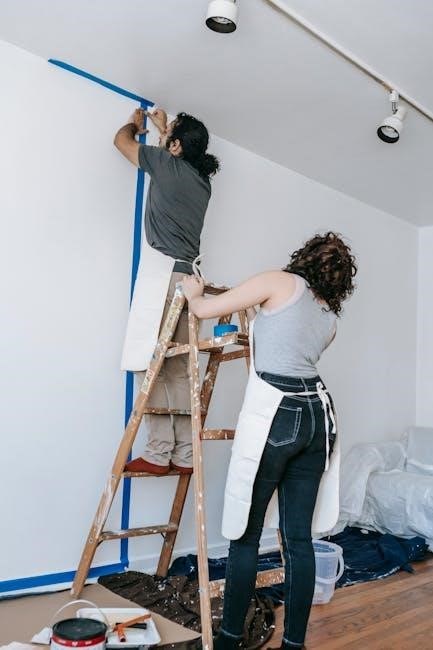
Preparation for Painting
Proper preparation is key to a successful painting project. Clean and repair walls‚ tape surfaces‚ and plan your approach to ensure a smooth and professional finish.
2.1 Cleaning and Repairing Walls
Clean walls thoroughly with a mild soap solution to remove dirt and grease. Repair cracks and holes with spackling compound‚ sand smooth‚ and wipe away dust. Ensure surfaces are dry and even before painting for optimal results. Address any water stains or peeling paint to create a stable base for your new coat of paint.
2.2 Taping and Protecting Surfaces
Use painter’s tape to mask off trim‚ baseboards‚ and moldings. Protect floors and furniture with drop cloths or plastic covers. Apply tape carefully to ensure sharp‚ clean lines. Remove tape immediately after painting to prevent adhesive residue. This step ensures precise painting and safeguards surfaces from unwanted paint splatters or spills.
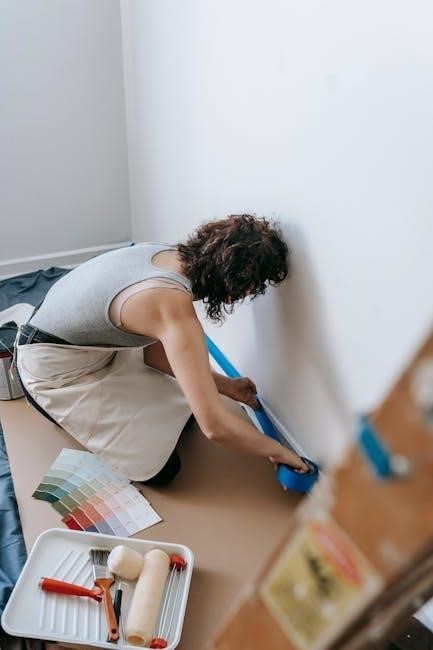
Choosing the Right Paint
Selecting the right paint ensures durability and aesthetics. Consider finish types like eggshell‚ satin‚ or semi-gloss for different rooms. Latex paint is popular for its ease of use and versatility in interior projects.
3.1 Types of Paint and Finishes
Understanding paint types and finishes is crucial. Latex paint‚ also known as water-based‚ is the most popular choice for interior walls due to its ease of use and quick drying time. Finishes include flat‚ eggshell‚ satin‚ semi-gloss‚ and high-gloss‚ each offering different durability and light reflection. Flat finishes hide imperfections well‚ while high-gloss is ideal for trim and doors. Choosing the right type and finish ensures a professional-quality result that suits your space and needs.
3.2 Selecting Colors and Testing Samples
Selecting the perfect color involves more than just liking a shade. Use color charts to narrow down options‚ then test samples on your walls. Paint testers or small sample pots allow you to see how colors look in your specific lighting. This step ensures the final result matches your vision‚ helping you make informed decisions and avoid costly mistakes.
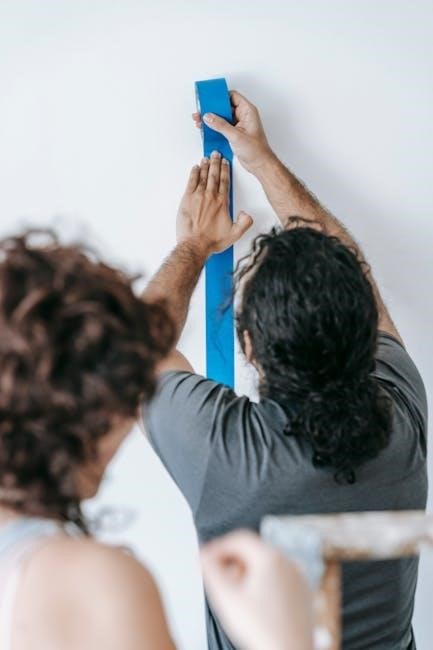
Paint Application Process
Apply paint smoothly using rollers or brushes‚ working in sections. Use long‚ even strokes for uniform coverage. Allow each coat to dry fully before additional layers for optimal results.
4.1 Tools and Equipment Needed
To ensure a smooth painting process‚ gather essential tools: high-quality brushes‚ rollers with extension poles‚ paint trays‚ drop cloths‚ sandpaper for surface preparation‚ masking tape for edges‚ and a primer for better adhesion. These tools will help achieve a professional finish and protect your surroundings from paint spills and splatters.
4.2 Step-by-Step Painting Techniques
Start by applying a primer to ensure better paint adhesion and coverage. Paint in small‚ manageable sections‚ using smooth‚ even strokes with your brush or roller. Work from top to bottom to prevent drips. Allow the first coat to dry completely before applying a second coat. Finish with touch-ups for any missed spots‚ blending edges for a seamless look.
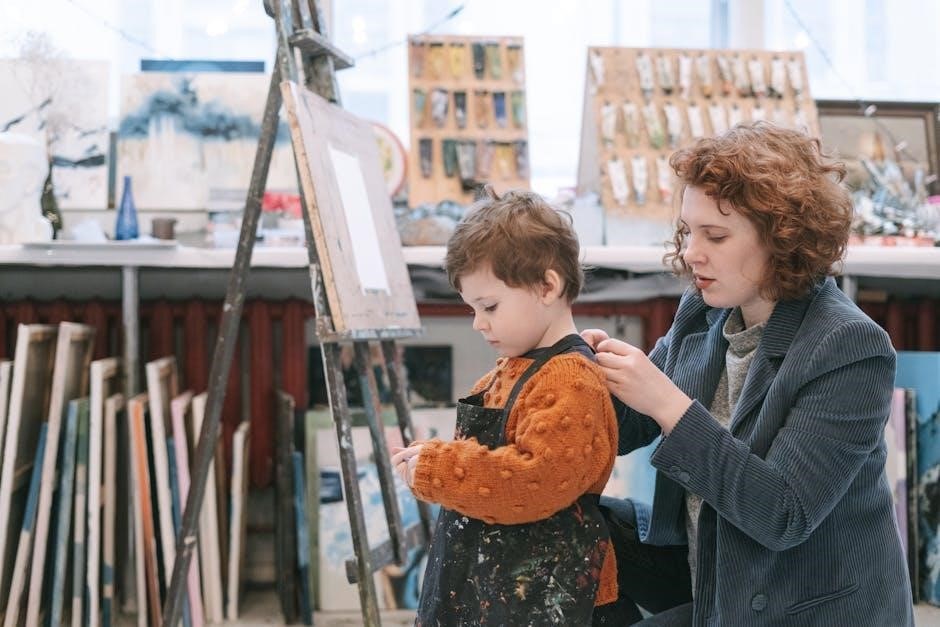
Finishing Touches
Finishing touches involve removing tape‚ cleaning tools‚ and inspecting for imperfections. Ensure all surfaces are spotless and well-protected for a polished look.
5.1 Allowing Paint to Dry
Allowing paint to dry is crucial for a flawless finish. Most paints require at least 24 hours to cure completely‚ while primer may need overnight drying. Ensure good ventilation and avoid touching surfaces during this period. Higher temperatures and humidity can slow drying times. Always follow manufacturer instructions for optimal results and wait at least a day before minor touch-ups.
5.2 Inspecting and Touching Up
After the paint has dried‚ inspect the surface for imperfections like uneven coverage or streaks. Use a small brush to touch up minor flaws‚ feathering edges to blend seamlessly. Avoid over-touching‚ as it may leave noticeable marks. Test samples on inconspicuous areas first to ensure color consistency. Regular inspections help maintain a polished look and prevent larger issues from arising over time.

Color Selection and Trends
Discover the latest trends in interior painting‚ from bold hues to neutral tones. Explore expert advice on selecting colors that enhance your space and reflect current design trends.
6.1 Current Color Trends
Explore the latest color trends for interior painting‚ featuring earthy tones‚ soft pastels‚ and deep blues and greens. These hues create calming‚ nature-inspired environments. Neutral tones like warm grays and creamy whites remain popular for their versatility and modern appeal‚ while bold accents add personality to spaces‚ reflecting current design aesthetics.

6;2 Matching Colors with Interior Design
When selecting colors for your space‚ consider your interior design style. Use color charts and sample pots to test hues against furniture‚ flooring‚ and decor. Neutral tones like soft grays and creamy whites complement modern aesthetics‚ while bold colors can enhance traditional designs. Pair complementary or analogous colors for harmony‚ ensuring your paint choices elevate the overall ambiance of your home.
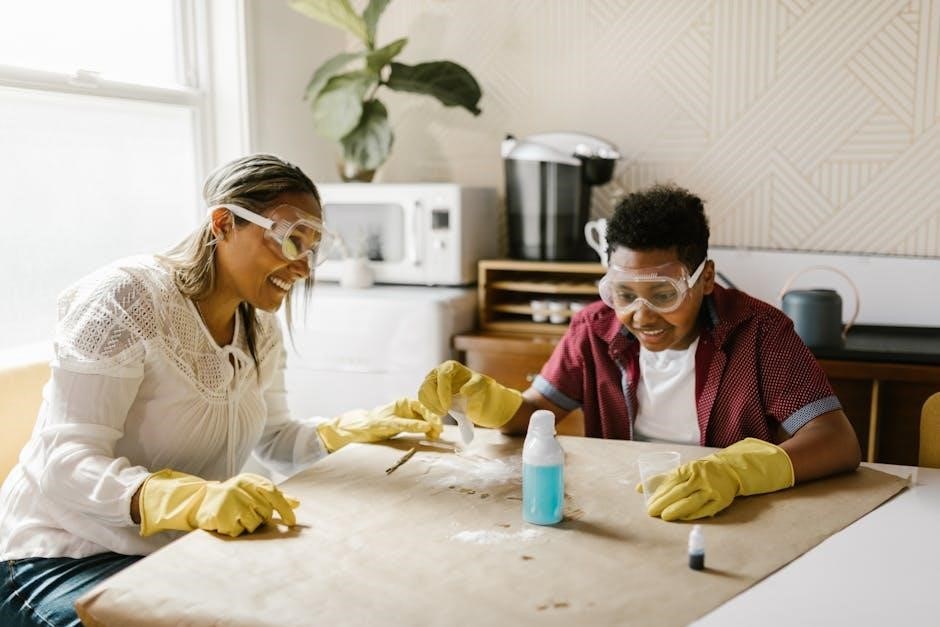
Maintenance and Upkeep
Regularly clean painted surfaces with gentle cleaners to prevent dirt buildup. Inspect for wear and tear‚ and schedule touch-ups every 5-7 years to maintain a fresh appearance.
7.1 Cleaning Painted Surfaces
Regular cleaning painted surfaces is essential for maintaining their appearance. Use a gentle cleaner and water to avoid damaging the paint. For latex-based paints‚ a mild detergent solution works well. Avoid harsh chemicals or abrasive materials that might scratch the surface. For oil-based paints‚ use a diluted vinegar solution. Always dry the surface thoroughly after cleaning to prevent water spots. Dust surfaces regularly to reduce dirt buildup. For stubborn stains‚ lightly scrub with a soft cloth. Microfiber cloths are ideal for preventing scratches. Regular maintenance ensures the paint remains vibrant and protected for years. Always test cleaning solutions on a small area first to ensure compatibility. This simple care extends the life of your interior paint job.
7.2 Scheduling Regular Touch-Ups
Regular touch-ups are crucial for maintaining the appearance and durability of painted surfaces. Schedule inspections seasonally or annually‚ focusing on high-traffic areas and surfaces exposed to moisture or wear. Address chips‚ cracks‚ or fading promptly to prevent further deterioration. Store leftover paint for quick fixes and blend colors seamlessly. This proactive approach ensures your paint job remains vibrant and protects your walls from damage.

Special Surfaces and Considerations
Explore expert tips for painting unique surfaces like metal‚ wood‚ and uPVC. Learn how to handle materials requiring special preparation or techniques to ensure a flawless‚ long-lasting finish.
8.1 Painting Trim‚ Doors‚ and Windows
Painting trim‚ doors‚ and windows requires precision and the right techniques. Start by priming if necessary‚ then apply high-quality paint with a brush for smooth finishes. Remove hardware and tape edges for clean lines. Use semi-gloss or high-gloss paints for durability. Work in sections‚ allowing each area to dry before moving on. This ensures a professional-looking result that enhances your home’s interior style.
8.2 Handling Different Materials
When painting various materials‚ consider their unique needs. Wood surfaces may require sanding and priming for smooth results. Metal surfaces need rust treatment and specialized paints. For uPVC‚ use acrylic-based paints to ensure proper adhesion. Always choose the right paint type for the material to achieve a durable and attractive finish that lasts. Proper preparation is key to success;

Essential Tools and Care
Invest in high-quality brushes‚ rollers‚ and trays for smooth results. Regularly clean and store tools to maintain their performance and extend their lifespan for future projects.
9.1 Must-Have Painting Tools
Essential tools for a successful painting project include high-quality brushes‚ rollers with extension poles‚ paint trays‚ drop cloths‚ sandpaper‚ masking tape‚ and a ladder. Brushes are ideal for trim and details‚ while rollers cover large areas quickly. Paint trays hold and transport paint efficiently‚ and drop cloths protect surfaces from spills. Sandpaper ensures smooth wall preparation‚ and masking tape creates sharp‚ clean lines. A sturdy ladder is crucial for reaching high areas safely. These tools collectively ensure a professional finish and streamline your workflow.
9.2 Maintaining and Storing Tools
Properly clean and store painting tools to extend their lifespan. Wash brushes and rollers with soap and water‚ or solvent for oil-based paints‚ before allowing them to dry. Store tools in a dry‚ cool place to prevent rust and damage. Regularly inspect tools for wear and tear‚ replacing worn bristles or rollers as needed. This ensures optimal performance for future projects and protects your investment.
Mastering interior painting requires patience‚ preparation‚ and practice. Follow these tips for a flawless finish: plan meticulously‚ choose quality tools‚ and maintain your equipment. Happy painting!
10.1 Summarizing Key Points
Planning and preparation are crucial for a successful painting project. Choose the right tools‚ select high-quality paint‚ and ensure surfaces are clean and repaired. Apply primer for better adhesion and durability. Use proper painting techniques‚ such as working in sections and maintaining even strokes. Allow paint to dry fully between coats. Regular maintenance and touch-ups will keep your space looking fresh. Always store tools properly to extend their lifespan.
10.2 Encouragement and Final Advice
Embark on your painting journey with confidence! Remember‚ every brushstroke brings you closer to a beautiful transformation. Stay patient‚ take breaks when needed‚ and don’t hesitate to seek advice. Celebrate small victories and enjoy the process of creating a space that reflects your style. Happy painting!





